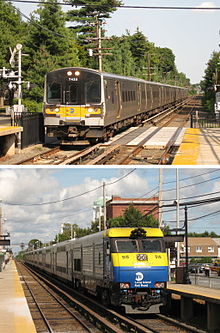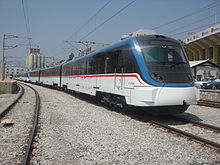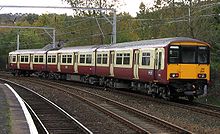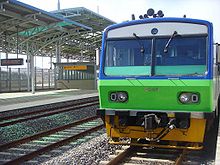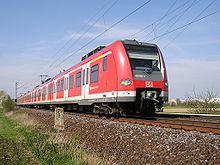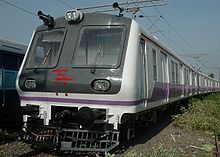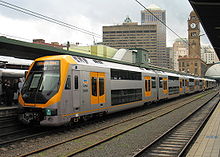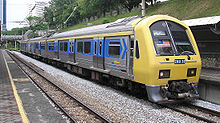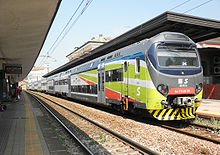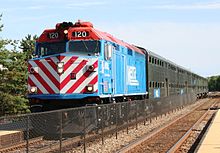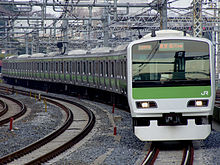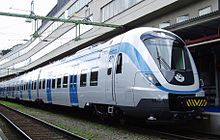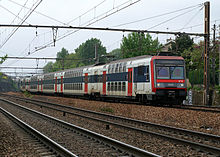- Commuter rail
-
A Southeastern commuter train at Slade Green in South East London, England, running a service to London Cannon Street.
 Mumbai Suburban Railway, the lifeline of Mumbai, carries more than 6.9 million commuters on a daily basis
Mumbai Suburban Railway, the lifeline of Mumbai, carries more than 6.9 million commuters on a daily basis
Commuter rail, also called suburban rail, is a passenger rail transport service that primarily operates between a city center, and the middle to outer suburbs beyond 15km (10 miles) and commuter towns or other locations that draw large numbers of commuters—people who travel on a daily basis. Trains operate following a schedule, at speeds varying from 50 to 200 km/h (30 to 125 mph). Distance charges or zone pricing may be used.
Non-English names include Treno suburbano in Italian, Cercanías in Spanish, Nahverkehrszug in German (and in most larger cities S-Bahns though these trains also often include city centre metro-like sections where lines have merged together and services become more frequent, and stations are closer together to better distribute passengers into the city core),Train de banlieue in French, Příměstský vlak in Czech and Elektrichka in Russian. The development of commuter rail services has become popular today, with the increased public awareness of congestion, dependence on fossil fuels, and other environmental issues, as well as the rising costs of owning, operating and parking automobiles.
Contents
Characteristics
Most commuter (or suburban) trains are built to main line rail standards, differing from light rail or rapid transit (metro rail) systems by:
- being larger
- providing more seating and less standing room, for the longer distances involved
- having (in most cases) a lower frequency of service
- having scheduled services (i.e. trains run at specific times rather than at specific intervals)
- serving lower-density suburban areas, typically connecting suburbs to the city center
- sharing track or right-of-way with intercity or freight trains
- not fully grade separated (containing at-grade crossings with crossing gates)
Train schedule
Compared to rapid transit (or metro rail), commuter/suburban rail has lower frequency, following a schedule rather than fixed intervals, and fewer stations spaced further apart. They primarily serve lower density suburban areas (non inner-city), and often share right-of-way with intercity or freight trains. Some services operate only during peak hours. Average speeds are high, often 50 km/h (30 mph) or higher. These higher speeds better serve the longer distances involved. Some services include express services which skip some stations in order to run faster and separate longer distance riders from short-distance ones.
The general range of commuter trains' distance varies between 15 and 200 km (10 and 125 miles).
Track
Their ability to coexist with freight or intercity services in the same right-of-way can drastically reduce system construction costs. However, frequently they are built with dedicated tracks within that right-of-way to prevent delays, especially where service densities have converged in the inner parts of the network.
Most such trains run on the local standard gauge track. Some light rail systems may run on a narrower gauge. Examples of narrow gauge systems are found in Japan, Switzerland, in the Brisbane (Citytrain) and Perth (Transperth) systems in Australia, and on the Genoa-Casella line in Italy. Some countries, including India, Pakistan, Russia, Brazil and Sri Lanka, as well as Melbourne in Australia, use broad gauge.
Distinction between other modes of rail
Metro
Metro rail or rapid transit usually covers a smaller inner-urban area ranging outwards to between 12km to 20km (or 8 to 14 miles), has a higher train frequency and runs on separate tracks (underground or elevated), whereas commuter rail often shares tracks, technology and the legal framework with mainline railway.
However, the classification as a metro or rapid rail can be difficult as both may typically cover a metropolitan area exclusively, run on separate tracks in the centre, and often feature purpose-built rolling stock. The fact that the terminology is not standardised across countries (even across English-speaking countries) further complicates matters. The distinction is most easily made when there are two systems such as New York's subway and the LIRR and Metro-North, Paris' RER and Métro, London's Overground and the tube lines of the Underground, the S-Bahn and U-Bahn systems in Berlin, Frankfurt, Munich or Vienna, the JR lines and the Metro in Tokyo.
Regional rail usually provides rail services between towns and cities, rather than purely linking major population hubs in the way inter-city rail does. Regional rail operates outside major cities. Unlike Inter-city, it stops at most or all stations between cities. It provides a service between smaller communities along the line, and also connections with long-distance services at interchange stations located at junctions or at larger towns along the line. Alternative names are "local train" or "stopping train". Examples include the former BR's Regional Railways, France's TER (Transport express régional) and Germany's DB Regio services. Regional rail does not exist in this sense in the United States, so the term "regional rail" has become synonymous with commuter rail there, although the two are more clearly defined in Europe.
In some European countries the distinction between commuter trains and long-distance/intercity trains is very hard to make, because of the relatively short distances involved. For example, so called "intercity" trains in Belgium and the Netherlands carry many commuters and their equipment, range and speeds are similar to those of commuter trains in some larger countries.
Russian commuter trains, on the other hand, frequently cover areas larger than Belgium itself, although these are still short distances by Russian standards. They have a different ticketing system from long-distance trains, and in major cities they often operate from a separate section of the train station.
The easiest way to identify these "Inter-city" services is that they tend to operate as express services - only linking the main stations in the cities they link, not stopping at any other stations. However, this term is used in Australia (Sydney for example) to describe the regional trains operating beyond the boundaries of the suburban services, even though some of these "inter-city" services stop all stations similar to German regional services. In this regard, the German service delineations and corresponding naming conventions are clearer and better used for academic purposes.
Sometimes high-speed rail can serve daily use of commuters. The Japanese Shinkansen high speed rail system is heavily used by commuters in the Greater Tokyo Area. They commute between 100 and 200 km by Shinkansen.[citation needed] To meet the demand of commuters, JR sells commuter discount passes and operates 16 car bilevel E4 Series Shinkansen at rush hour, providing a capacity of 1,600 seats. Several lines in China such as Guangzhou-Zhuhai Intercity Mass Rapid Transit, the Beijing–Tianjin Intercity Railway, and the Shanghai–Nanjing High-Speed Railway, serve a similar role with many more under construction or planned. The high-speed services linking Zurich, Bern and Basel in Switzerland have brought the Central Business Districts (CBDs) of these three cities within 1 hour of each other. This has resulted in unexpectedly high demand for new commuter trips between the three cities and a corresponding increase in suburban rail passengers accessing the high-speed services at the main city-centre stations (or Hauptbahnhof).
Train types
Commuter/suburban trains are usually optimized for maximum passenger volume, in most cases without sacrificing too much comfort and luggage space, though they seldom have all the amenities of long-distance trains. Cars may be single- or double-level, and aim to provide seating for all. Compared to intercity trains, they have less space, fewer amenities and limited baggage areas.
Multiple unit type
Commuter rail trains are usually composed of multiple units, which are self-propelled, bidirectional, articulated passenger rail cars with driving motors on each (or every other) bogie. Depending on local circumstances and tradition they may be powered either by diesel engines located below the passenger compartment (diesel multiple units) or by electricity picked up from third rails or overhead lines (electric multiple units). Multiple units are almost invariably equipped with control cabs at both ends, which is why such units are so frequently used to provide commuter services, due to the associated short turn-around time.
Locomotive hauled services
Locomotive hauled services are used in some countries or locations. This is often a case of asset sweating, by using a single large combined fleet for intercity and regional services. Loco hauled services are usually run in push-pull formation, that is, the train can run with the locomotive at the "front" or "rear" of the train (pushing or pulling). Trains are often equipped with a control cab at the other end of the train from the locomotive, allowing the train operator to operate the train from either end. The motive power for locomotive-hauled commuter trains may be either electric or Diesel-electric, although some countries, such as Germany and some of the former Soviet-bloc countries, also use diesel-hydraulic locomotives.
Seat plans
In the U.S. and some other countries, a three-and-two seat plan is used. However, few people sit in the middle seat on these trains because they feel crowded and uncomfortable.[1] It is said one industrial designer for one of New York City's commuter railroads, Metro-North, told people: "I designed the aisle seat with a half-back and no upholstery, so it will be very uncomfortable to sit there. They'll move in and take the center seat!"[2] (This seating design can also be found on older New Jersey Transit and Long Island Rail Road rolling stock.)
In Japan, longitudinal (sideways window-lining) seat is widely used in some commuter rail to increase capacity in rush hours. Carriages are not organized to increase seating capacity even in the case of commuting longer than 50 km and commuters in Greater Tokyo Area have to stand in the train for more than an hour.
Commuter rail in the world
Africa
Currently there are not many examples of commuter rail in Africa. Metrorail operates in the major cities of South Africa, and there are some commuter rail services in Algeria, Morocco and Tunisia. In Algeria, SNTF operates commuter-rail lines between the capital Algiers and its southern and eastern suburbs. They also serve to connect Algiers' main universities to each other .
Asia
In Japan, commuter rail systems have extensive network and frequent service, and are heavily used. It is notable that many of them are run by private railway companies.
In India, commuter rail systems are present in major cities. Mumbai Suburban Railway, the oldest suburban rail system in Asia, carries more than 6.9 million commuters on a daily basis which constitutes more than half of the total daily passenger capacity of the Indian Railways itself. Kolkata Suburban Railway is huge and extensive and covers large areas in Kolkata's hinterland. The Chennai Suburban Railway is another railway of comparison. In Hyderabad, the MMTS mainly transports people from the city centre to HI-TEC city, the city's Information Technology hub. Other commuter railways in India include Delhi Suburban Railway, Pune Suburban Railway and Lucknow-Kanpur Suburban Railway.
Commuter trains are currently uncommon in China, although a small system has been inaugurated in Beijing in 2008. Commuter rail systems are also planned for Shanghai, Nanjing, Tianjin and around the Pearl River Delta region.
In Iran, SYSTRA has done a "Tehran long term urban rail study". SYSTRA proposed 4 express lines which are similar to RER suburban lines in Paris. Tehran Metro is going to construct express lines. For instance, the Rahyab Behineh, a consultant for Tehran Metro, is studying Tehran Express Line 2. Tehran Metro currently has a commuter line between Tehran and Karaj.
Other examples in Asia include Seoul Metropolitan Subway which has suburban lines operated by Korail in South Korea, KTM Komuter in Malaysia, The Philippine National Railways orange line in Metro Manila, Philippines and, KRL Jabotabek in Jakarta Metropolitan area, Indonesia.
Europe
Major metropolitan areas in most European countries are usually served by extensive commuter/suburban rail systems. Well-known examples include Beovoz in Belgrade, Serbia, S-Bahn in Germany, Switzerland and Austria, Proastiakos in Greece, RER in France, Linee S in Milan (Italy), Cercanías in Spain and HÉV in Budapest, Hungary.
In Russia, Ukraine and some other countries of the former Soviet Union, electrical multiple unit passenger suburban trains called Elektrichka are widespread.
North America
In the United States, Canada, and Mexico regional passenger rail services are provided by governmental or quasi-governmental agencies, with a limited number of metropolitan areas served.
South America
Examples include an 899 km (559 mi) commuter system in the Buenos Aires metropolitan area, the 225 km (140 mi) long Supervia in Rio de Janeiro, and the Metrotrén in Santiago, Chile. Another example is Companhia Paulista de Trens Metropolitanos (CPTM) in Greater São Paulo, Brazil. CPTM has 93 stations with six lines, numbered starting on 7 (the lines 1 to 6 belong to the São Paulo Metro), with a total length of 260.8 kilometres (162.1 mi).
Oceania
Major cities in Australia have suburban railway systems in their metropolitan areas. As with Japanese suburban railways or Germany's and Switzerland's S-Bahns, these Australian networks have far more frequent services and far higher ridership per capita than US 'commuter rail' in the usual sense of the term. To some US observers these networks may appear to operate as commuter/metro hybrids, however, they are simply the result of full utilisation of the available track capacity in the core of the suburban rail network, this being fed from multiple feeder lines. This is particularly so in Sydney and Melbourne, where headways on many lines in the core of the network reach 3–5 minutes in peaks and 10–20 minutes off peak (about 18 hours a day) and enter an underground loop for passenger distribution in the city centre; and where ridership per capita exceeds the sum of metro and commuter rail in comparable North American urban areas such as Toronto, Boston or the San Francisco Bay Area. All systems, however, are based on established main line rail systems, and track sharing with inter-city and freight services on parts of the network inhibit higher frequencies on some tracks. The main systems include:
- CityRail in Sydney, Newcastle and Wollongong. (largest metropolitan-wide network in Australia)
- Metro Trains Melbourne in Melbourne. ("Metro" being a technical misnoma)
- Queensland Rail in Brisbane.
- Transperth Trains in Perth.
- TransAdelaide in Adelaide.
New Zealand has two commuter rail systems: in Auckland and in Wellington (Tranz Metro).
See also
- Cercanías
- Commuter rail in the United Kingdom
- Commuter rail in North America
- Train categories in Europe
- Commuting
- List of suburban and commuter rail systems
- Noise mitigation
- Rail terminology
- Passenger rail terminology
- Public transport
- Lists of rail accidents
- Cityrail
- S-Bahn
References
External links
- Commuter Rail & Transit News Current news concerning commuter rail development and issues
Categories:- Regional rail systems
Wikimedia Foundation. 2010.

